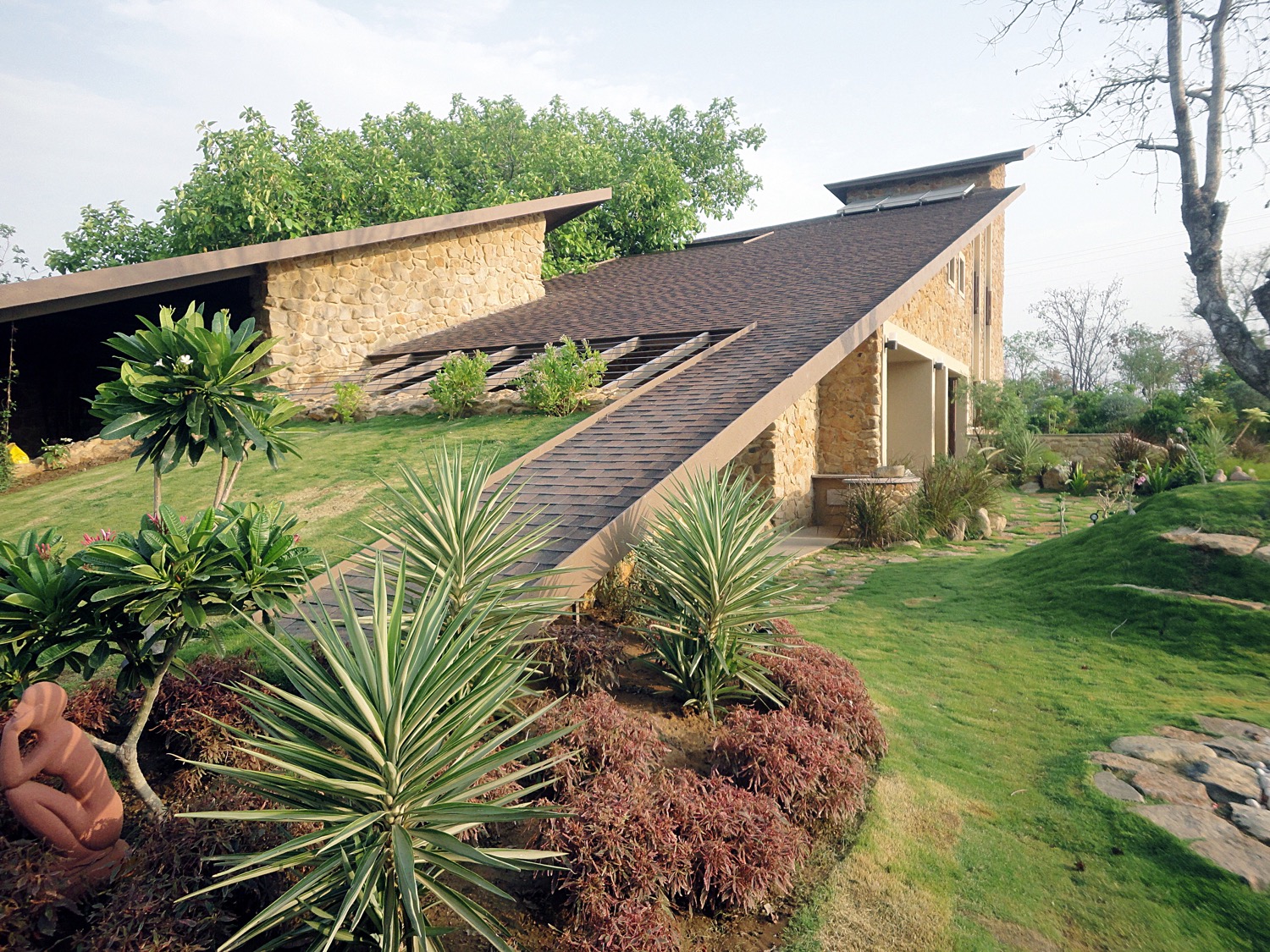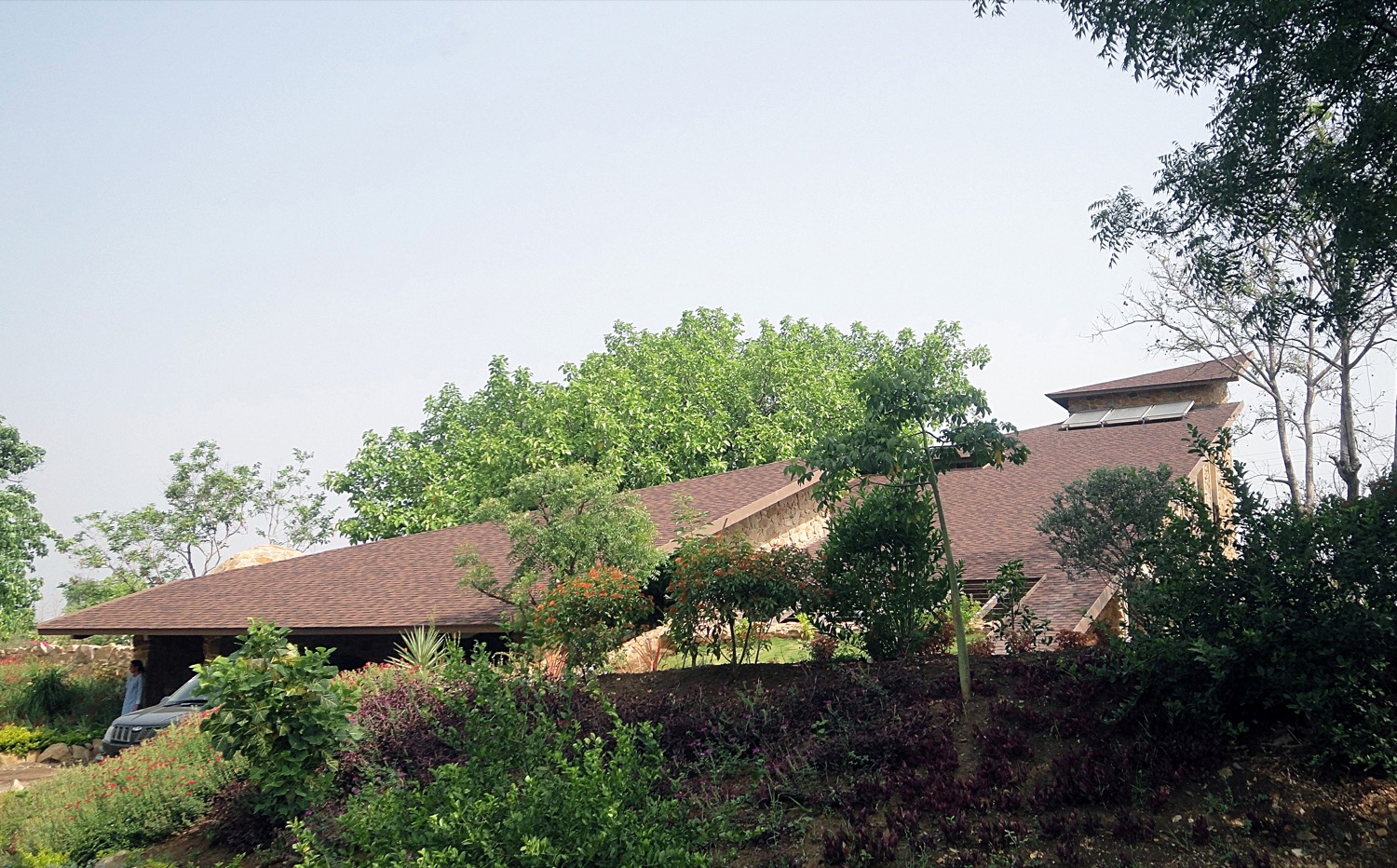After visiting my lake house at Andur on an invitation from my sister Vinita, her good friends, the Gandhis were very keen that I design their farmhouse at Wakeshwar near Nagpur. On my first visit to their 12 acre farm, they tentatively indicated me their preferred location for the proposed farmhouse. However, while moving around the farm, I was struck by the benevolent presence of a medium sized young Banyan tree … a ‘vat vriksha’. I immediately developed a rapport with it. While sitting under it and feeling it with my hands, I seemed to be asking its permission to build around it. Just then, I also noticed a certain link , a definite pull (communication) between this vat vriksha and another tree, ‘Behada’, that was nearby (about 40 metres away). I almost knew that both of them would be good company for our new house as well as its inmates. Thus, I decided to make this Banyan the central focus around which the house would be designed on it’s three sides. The fourth side was kept open to strengthen the rapport between the Banyan and the Behada tree by a linear lap pool with a peripheral space defining landscaped mound and yard wall. The three other smaller existing trees found their places near the temple, near the bed sit out and in the party lawn. The house, I felt, could not be just plonked as an alien element on the site but had to be rooted in the soil and also grow out of it. This house had to belong to this site; it had to make friends with the trees (especially the Banyan), the rocks, the soil, the sky and the people.
Thus the house gradually rises right from the ground in a tapered form on the south and the west side. The ochre skinned boulders obtained at site were used for the major masonry walls. They too helped in visually blending the house better with the site and made the abode more eco friendly with reduced embodied energy. Their rugged appearance would also be maintenance free. The design was made such that the man made spaces and the natural spaces blended with each other symbiotically with large openings, planters, water bodies etc. Similarly all bathrooms have an integral landscaped planters inside that makes the bathing experience more refreshing. By breaking the rigid boundaries between the enclosed spaces and the open spaces, one is compelled to ask whether the house is in the garden or the garden is in the house. The old approach to the farmhouse through the sheds of amenity functions was completely changed and taken from the other end through the sweet lime plantation. With this new meandering access, the farm house reveals itself only in the end as a surprise. We enter the house through a narrow covered passage placed on the North South axis of the Banyan As one emerges from this passage, the Banyan reveals itself in all its glory, bang in front of you. On the left side, we see the landscaped court with the lap pool and the Behada at the other end. On the right is the semi open verandah as a precursor to the main living & dining spaces. The experience at this entry point is not just visual. We hear the gurgling of a water stream coming through the house from the other side amidst the rustle of the Banyan leaves and the chirping birds; we smell the plants and the flowers and feel the westerly breeze on our skin. The rough hewn courtyard flooring massages the soles of our feet. While walking through this narrow entrance passage, on the perpendicular axis to this passage we have designed a primitive shrine (temple) with a primordial form of a stone dome.
One can get a glimpse of the lamp inside this shrine before reaching the arrival verandah. Even when we are inside the house, we do not loose contact with the beautiful outside environment. Our great banyan is visible from almost all spaces in the house. It sometimes overlaps the roof and spreads onto the terraces. The doors and windows too harbour the reflections of the outside nature. The living- dining spaces flow onto the banyan tree courtyard on one side and onto the party lawn garden on the other side. Both the bedrooms open out onto landscaped spaces outside as well as frame the banyan in their large square windows. The living dining space on the ground floor further rises up to merge with the overlooking indoor balcony of the master bedroom on first floor. This allows foe easy interaction between the people on the ground floor and those on the first floor. This indoor balcony again opens out on a small terrace that is caressed by the banyan branches. The master bed also has an access to a private terrace with a proposed Jacuzzi. Due to the shade of the banyan, the water bodies, thick stone masonry and the greens, it is noticed that the temperatures in this house are considerably lower than those outside. The landscaping avoids forced, formal, artificial layouts in order to create a more natural environment. The plant material too is selected and executed by Kavita …… accordingly, in harmony with the main theme The interiors also have been designed by Vinita Agge to gel with the overall rustic character of this farmhouse. Natural and rough cut wood, hemp, cane and fabric is chosen to create a more organic, natural ambience. Rustic flooring and rough plaster further contribute to this feeling. This farmhouse is proving to be a stress relieving haven from the outside stress ridden world. One feels a psychological transformation in one’s inner space as soon as one experiences this outer space. The spaces here, with major help from our Vat vriksha and the Behada, have acquired a tranquil, harmonizing and a joyous ambience. This can happen only when we are able to connect to our roots ..to mother nature.





















One Response
It’s so serene and beautiful